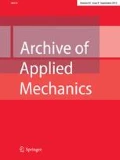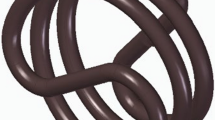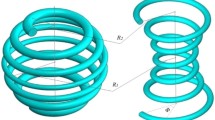Abstract
Helical springs belong to structures with spiral shapes and large curvatures, especially, traditional views that elemental shape functions are applied to interpolate shapes of structures, will result in plenty of elements and enormous computational cost. It is proved by this paper that selecting some characteristic parameters describing their shape regulations as variables can model the helical springs with almost no errors of model. Based on this thought, a geometrically nonlinear spring element for structural analysis of helical springs is proposed. First, strains irrelevant to rigid motions of cross sections and virtual deformation power of the curved beam with geometrical nonlinearity are derived. Next, parameters that generalized strains of spring elements depend on, namely helical radius, azimuth angles, height coordinates and torsion angles at one node of each coil are chosen as variables. A special shape function is built, in contrast of traditional shape functions, they can approximate the structure of helical springs accurately using less parameters. Then, nodal forces and generalized external forces as well as equilibrium equations are given, and in order to improve the computational efficiency, the Jacobian matrices are derived. Finally, two examples are considered to evaluate the accuracy of modeling and simulation against to ANSYS. Stiffness properties of cylindrical and conical springs are analyzed by the spring element. The proposed elements can give high-precision numerical results using less parameters from the comparison and be used an effective auxiliary tool for design of springs.




































Similar content being viewed by others
Abbreviations
- \({\varvec{g}}_{1} ,{\varvec{g}}_{2} ,{\varvec{g}}_{3}\) :
-
Base vectors of the global coordinate system
- \({\varvec{e}}_{s} ,{\varvec{e}}_{t} ,{\varvec{e}}_{b}\) :
-
Base vectors of the cross sections’ coordinate system
- \({{\varvec{\upkappa}}}\) :
-
The curvature vector
- \({{\varvec{\upomega}}}\) :
-
The vector of angular velocity
- \(\alpha ,\beta ,\gamma\) :
-
Cardan angles describing the rotations of cross sections
- \(\kappa_{s} ,\kappa_{t} ,\kappa_{b}\) :
-
Components of curvature vectors with respect to the cross sections’ coordinate system
- \(\omega_{s} ,\omega_{t} ,\omega_{b}\) :
-
Components of angular velocity with respect to the cross sections’ coordinate system
- \(\varepsilon_{s}\) :
-
Stretch ratio of are-lengths
- \(\sigma_{s}\) :
-
Normal stresses of cross sections
- \(\tau\) :
-
Shear stresses of cross sections
- \(\overline{s}\) :
-
Initial arc-length coordinates at nodes
- \(s\) :
-
Current arc-length coordinates at nodes
- \(\overline{\theta }\) :
-
Initial azimuth angles at nodes
- \(\overline{\rho }\) :
-
Initial helical radius of coils at nodes
- \(\overline{z}\) :
-
Initial height coordinates at nodes
- \(\theta\) :
-
Current azimuth angles at nodes
- \(\rho\) :
-
Current helical radius of coils at nodes
- \(z\) :
-
Current height coordinates at nodes
- \(\gamma\) :
-
Current torsion angles of cross sections at nodes
- \(\user2{f}^{e}\) :
-
Nodal forces of spring elements
- \(\user2{f}^{a}\) :
-
Generalized external forces of spring elements
- \(\user2{G}\) :
-
Jacobian matrix of equilibrium equations of spring elements
- \(\user2{q}\) :
-
Nodal parameters’ vector of spring elements
- \(f_{a}\) :
-
The value of external forces applied to the top center of spring structures
- \(d\) :
-
Spring wire’s diameters of spring structures
- \(n\) :
-
The number of spring wire coils of spring structures
- \(D\) :
-
Helical diameters of spring structures
- \(EA,GJ,EI_{t} ,EI_{b}\) :
-
Constitutive modulus of spring structures
References
Robert, H., Jan, C., Heinz, U.: An efficient spring model based on a curved beam with non-smooth contact mechanics for valve train simulations. SAE Int. J. Engines 3(1), 28–34 (2010)
Pawar, H.B., Desale, D.D.: Optimization of three wheeler front suspension coil spring. Procedia Manuf. 20, 428–433 (2018)
Jiang, Q., Qiao, Y., Zhao, F., et al.: Composite helical spring with skin-core structure: structural design and compression property evaluation. Polym. Compos. 42, 1292–1304 (2021)
Thomson, W., Tait, P.G.: Treaties on natural philosophy, 2nd edn. Oxford, New York (1883)
Love, A.E.H.: A treatise on the mathematical theory of elasticity, 2nd edn. Cambridge at the University Press, Cambridge (1906)
Ancker, C.J., Goodier, J.N.: Pitch and curvature corrections for helical springs. J. Appl. Mech. 25, 466–470 (1958)
Wahl, A.M.: Mechanical Springs. McGraw-Hill, New York (1963)
Wittrick, W.H.: On elastic wave propagation in helical springs. Int. J. Mech. Sci. 8, 25–47 (1966)
Pearson, D., Wittrick, W.H.: An exact solution for the vibration of helical springs using a Bernoulli-Euler model. Int. J. Mech. Sci. 28, 83–96 (1986)
Lin, Y., Pisano, A.P.: General dynamic equations of helical springs with static solution arid experimental verification. ASME J. Appl. Mech. 54, 910–917 (1987)
Lin, Y., Pisano, A.P.: The differential geometry of the general helix as applied to mechanical springs. ASME J. Appl. Mech. 55, 831–836 (1988)
Okarmus, M., Keribar, R., Dascalescu, D., Zdrodowski, R.: An efficient, one-dimensional, finite element helical spring model for use in planar multi-body dynamics simulation. SAE Int. J. Engines 6(2), 979–989 (2013)
Frendo, F., Vitale, E., Carmignani, L., et al.: Development of a lumped-parameter model for the dynamic analysis of valve train systems. Small Engine Technol. Conf. Expos. 1, 32–51 (2004)
Pisano, A.P., Freudenstein, F.: An experimental and analytical investigation of the dynamic response of a high-speed cam-follower system. Part 2: A combined, lumped/distributed parameter dynamic model. J. Mech. Des. 105, 699–704 (1983)
Guo, J., Zhang, W., Zou, D.: Investigation of dynamic characteristics of a valve train system. Mech. Mach. Theory 46, 1950–1969 (2011)
Rob, J., Arnold, M.: Analysis of dynamic interactions in valve train systems of IC-engines by using a simulation model. Int. Congr. Expo. 1, 930616 (1993)
Dalpiaz, G., Rivola, A.: A non-linear elastodynamic model of a desmodromic valve train. Mech. Mach. Theory 35, 1551–1562 (2000)
Rivolaa, A., Troncossia, M., Dalpiazb, G., Carlinic, A.: Elastodynamic analysis of the desmodromic valve train of a racing motorbike engine by means of a combined lumped/finite element model. Mech. Syst. Signal Process. 21, 735–760 (2007)
Gatti, G., Mundo, D.: On the direct control of follower vibrations in cam-follower mechanisms. Mech. Mach. Theory 45, 23–35 (2010)
Mottershead, J.E.: Finite elements for dynamical analysis of helical rods. Int. J. Mech. Sci. 22(5), 267–283 (1980)
Iritani, T., Shozaki, A., Sheng, B., et al.: Prediction of the dynamic characteristics in valve train design of a diesel engine. C R Acad. Sci. Hebd. Seances Acad. Sci. D. 1(1), 1–7 (2002)
Ke, Q., Pan, J.Y., et al.: Geometric nonlinear dynamic analysis of curved beams using curved beam element. Acta. Mech. Sin. 27(6), 1023–1033 (2011)
Zeng, S., Chen, S., Wang, H., et al.: Finite element analysis of spatial curved beam in large deformation. Southeast Univ. (English Ed.) 26(4), 591–596 (2010)
Stander, N., Preez, R.: Vibration analysis of coil springs by means of isoparametric curved beam finite elements. Commun. Appl. Numer. Methods. 8, 373–383 (1992)
Taktak, M., Dammak, F., Abid, S., et al.: A mixed-hybrid finite element for three-dimensional isotropic helical beam analysis. Int. J. Mech. Sci. 47(2), 209–229 (2005)
Fakhreddine, D., Mohamed, T., Said, A., et al.: Finite element method for the stress analysis of isotropic cylindrical helical spring. Eur. J. Mech. 24(6), 1068–1078 (2005)
Renno, J.M., Mace, B.R.: Vibration modelling of helical springs with non-uniform ends. J. Sound Vib. 331(12), 2809–2823 (2012)
Waki, Y., Mace, B.R., Brennan, M.J.: Numerical issues concerning the wave and finite element method for free and forced vibrations of waveguides. J. Sound Vib. 327(1–2), 92–108 (2009)
Yang, C.J., Zhang, W.H., Ren, G.X., et al.: Modeling and dynamics analysis of helical spring under compression using a curved beam element with consideration on contact between its coils. Meccanica 49(4), 907–917 (2014)
Gu, Z., Hou, X., Ye, J.: Advanced static and dynamic analysis method for helical springs of non-linear geometries. J. Sound Vib. 513, 1114 (2021)
Zhang, Y.H., Liu, H.H., Wang, D.C.: Spring manual. China Machine Press, Beijing (2008)
Acknowledgements
This work has been supported by the National Natural Science Foundation of China(Grant No. 11802048, No. 11872137 and No. 91748203).
Author information
Authors and Affiliations
Corresponding author
Ethics declarations
Conflict of interest
The authors declare that they have no known competing financial interests or personal relationships that could have appeared to influence the work reported in this paper.
Additional information
Publisher's Note
Springer Nature remains neutral with regard to jurisdictional claims in published maps and institutional affiliations.
Rights and permissions
About this article
Cite this article
Zhuo, Y., Qi, Z., Zhang, J. et al. A geometrically nonlinear spring element for structural analysis of helical springs. Arch Appl Mech 92, 1789–1821 (2022). https://doi.org/10.1007/s00419-022-02147-9
Received:
Accepted:
Published:
Issue Date:
DOI: https://doi.org/10.1007/s00419-022-02147-9




